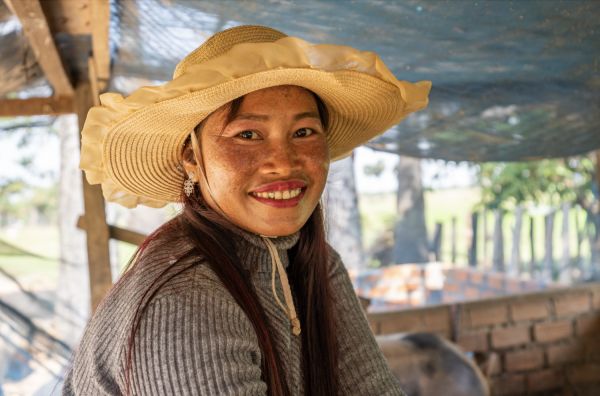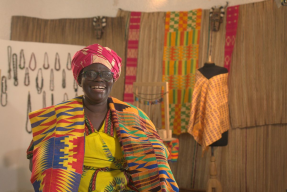Top 10 things to know about microfinance
April 14, 2022
Pioneered in the 1970s, microfinance—the practice of making financial services available to underserved communities—is now used all over the world.
Whether you’re new to the concept or just looking for more information, here are ten things to know about what microfinance is and how it works.
1. Microfinance offers financial services to those who have been excluded from traditional banking spaces.
More than 1.7 billion people around the globe—31 percent of adults—are considered “unbanked,” meaning they don’t have access to bank accounts, savings options, or credit lines. Whether it’s due to living in rural locations or to socioeconomic factors like a lack of education, this “financial exclusion” often correlates with low income and systemic inequality. Microfinance opens up channels to financial services that allow previously financially excluded people more opportunities for stability and prosperity.
2. Microfinance includes more than loans.
When people think of microfinance, their first association is usually with microloans or microcredit. While the entry point for many individuals are small loans used to buy raw materials for their business or to fund their education, microfinance can also encompass a suite of other services: Savings accounts allow entrepreneurs or individuals a safe place to park their money and earn a bit of interest, and insurance products allow people to mitigate risks. Deposits, fund transfers, and payment services are also tools that can contribute to increased financial health.
3. Microfinance increases opportunities for individual agency.
Access to small loans, business training, and other financial services enables individuals to move towards financial independence, allowing them to make financial decisions that impact their families and their future positively. For vulnerable groups—including women, refugees, and minority ethnic groups—microfinance supports self-reliance.
4. Microloans have very high repayment rates.
Repayment rates for microloans are very high, despite the fact that microloans are often provided to those who are typically defined by traditional financial institutions as ‘risky’—because they do not have a credit history, a large income, or collateral.
Kiva allows lenders to research and choose the borrowers that they want to fund. For as little as $25, anyone can contribute to a loan requested by a borrower, creating a connection between two people, often living on different continents. When the loan is repaid—as 96 percent are—lenders receive their money back, giving them the opportunity to fund another borrower.
5. Operating costs are high for MFIs.
It takes a lot of work to provide microfinance services, much of it carried out by microfinance institutions (MFIs). These are the organizations within communities disbursing loans, collecting repayments, providing financial literacy training, getting feedback from borrowers, and more. For each microloan, an MFI employee must put in the time, labor, and administrative attention to make sure the borrower understands the terms of the loan and follow up on a repayment schedule. Many MFIs work with clients in rural areas, often combining education and other financial services in their weekly visits—which is part of why it’s much more expensive to disburse many small loans rather than one big loan.
6. Many microfinance institutions charge interest.
Many MFIs cover their operating costs by charging interest on their loans. These interest rates can be high by formal sector standards but are actually low relative to the informal market of supplier credit and loan sharks. This means incentives for both microfinance target borrowers and lenders coincide.
Factors such as inflation and domestic conflict also drive up costs for MFIs. The interest charged on loans allows MFIs to run a sustainable business, in order to continue their mission to reach more financially excluded individuals. Loan size is typically based on a household's monthly cash flow, which has the advantage of disconnecting the performance of the loan from any single activity within the array that the households of the working poor usually manage. It also helps prevent over-indebtedness.
At Kiva, we work with over 150 MFIs in 69 different countries, who help distribute loans fundraised on Kiva.org to individuals on the ground. These Field Partners share Kiva’s social mission and have a strong commitment to serving the needs of poor, vulnerable and/or excluded populations. As well as vetting partners before deciding to work together to ensure that their lending processes are responsible and fair, we monitor microfinance providers throughout our partnerships with the aim of ensuring client protection.
You can learn more about microfinance interest rates here.
7. Microloans can help increase incomes and improve livelihoods.
 Hadeel's Kiva loan allowed her to buy tools for her work, improving her production and enhancing her income.
Hadeel's Kiva loan allowed her to buy tools for her work, improving her production and enhancing her income.The impact of microlending is measured by the borrowers themselves. In Kenya, rural farmers who borrowed through Kiva Field Partner One Acre Fund reported increased incomes of 40 to 50 percent compared to a control group; similarly in Bolivia, dairy farmers that are clients of MFI Sembrar Sartawi increased their profits by 50 percent. An external impact study of Bangladeshi-based global MFI BRAC found that 92 percent of clients who were surveyed had increased their earnings after working with the organization. Positive impact can also be measured by increased feelings of safety, as reported by 94 percent of customers in Madagascar who purchased a Boabab+ solar system on credit, as well as by increased savings on energy costs, exemplified by borrowers who bought more efficient BURN cookstoves with their loans.
8. Microfinance continues to grow.
The demand for microfinance continues to build. In response to the UN’s Sustainable Development Goals which were set in 2015, the industry has begun to focus on not only increasing pathways to loans for the financially excluded but also on access to education, gender equality, housing, health services, agricultural practices, and renewable energy. Microloans were made to more than 140 million borrowers in 2018, 80 percent of them women. Global funding for microfinance reached USD$60 billion in 2020, and the microfinance market is expected to exceed USD$300 billion by 2026.
9. More needs to be done to address systemic issues.
While it was heralded in its beginnings as the solution to global poverty, microfinance is just one strategy to open access and economic opportunities. Many people in developing and developed countries face circumstances that reinforce systemic poverty, such as lack of health services and education, poor public infrastructure, and social and gender inequality. These and other systemic issues need to be addressed in order to reach the UN’s Sustainable Development Goal of ending poverty in all its forms. What microfinance can do is promote financial inclusion and access to capital in communities, increasing people’s capacity to grow their incomes and improve livelihoods.
Kiva also works on innovative programs like Kiva Labs (funds for mission-driven international organizations) and Kiva Capital (scalable impact investments for financial inclusion) which are designed to address the systemic challenges that make microfinance essential.
10. Microfinance makes a real impact in people’s lives.
From helping farmers increase their harvest and funding college educations for girls to supporting female entrepreneurs and enabling refugees to start a business in a new country, microfinance has helped millions of people pursue opportunities that they may not have otherwise been able to. MFIs disburse loans that raise quality of life by helping to provide safe drinking water to communities and close the gender gap in entrepreneurship all over the globe. Access to savings accounts, fund transfers, and business training can turn a small venture into a burgeoning enterprise that creates jobs for others.
Millions—even billions—of people around the globe continue to be impacted by microfinance’s mission: to make positive change through financial inclusion.
Want to get involved? Fund a Kiva loan today.
PREVIOUS ARTICLE
Bringing clean water to schools and communities through innovative finance →NEXT ARTICLE
Cooking clean: the innovative energy system that's helping the environment and improving Salao’s life →













